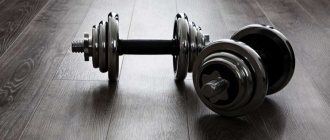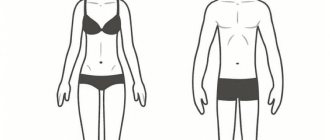The training program must clearly correspond to the goal that the athlete has set for himself. When gaining weight, some principles are used, and when losing weight, others are used.
It is important to take into account all the features, otherwise you will not be able to achieve the result.
Daily training is very exhausting. Not everyone will be able to withstand such a regime, and such an amount of free time is also not always available. 3-4 classes a week will be enough to fully work out the whole body and provide the body with rest.
All the pros and cons of four-day classes
The three-day split is the most popular type of workout. We know much less about the four-day regime, however, this option is often used in practice. It has its advantages and disadvantages that must be taken into account.
The positive points include:
- There are 3 free days left per week, which is enough for recovery;
- You can conveniently “scatter” different muscle groups throughout the day so that they don’t overlap.
The main negative point is that, given the seven-day week, it will not be possible to always have a full day off after class. At least once, two training sessions will take place back to back.
This problem can be partially solved by training at different times of the day, for example, on Monday there is a daytime workout, and on Tuesday there is an evening workout, the remaining two are on Thursday and Saturday. You can also train absolutely non-overlapping muscles these days.
How to avoid overtraining?
This is an equally important topic compared to how often to exercise. First of all, you need to monitor your progress. If you stop progressing in at least one exercise, this may indicate that you are close to overtraining.
In the example we considered above, this is what happened, because the builder noticed that he had stopped improving his results in the bench press. If a similar situation happened to you, then you should rest. Here are the three main symptoms of overtraining.
We recommend reading: How many times a week to pump your shoulders
- The working weight in exercises does not increase. To progress, you need to gradually increase the load. However, for this, the body must fully recover so that you can work with heavy weights.
- The number of repetitions or the time of static holding of projectiles does not increase. If the working weight does not increase, then the number of repetitions or the time of static holding of the projectile should increase.
- You spend more time doing the same workout. The effectiveness of training is closely related to the concept of intensity, which is measured in units of time. Simply put, if it took you longer to do an activity you did a few days ago today, then the intensity has dropped.
Options for basic exercise sets
The training program 4 times a week may vary. It all depends on the goal that the athlete sets for himself. For example, if you need to gain muscle mass, then you should divide the muscles into 4 groups and do your part every day; if you need to lose weight, then you can follow the principle of circuit training and change the program every one or two weeks.
Attention! There are many options for training programs. Each must correspond to a specific task set by the athlete.
Exercises for mass
Mass training should take into account a number of factors, including the recovery of the body. If the muscles are not restored, the next workout will only damage them further, and the situation will not change by the next session.
With a four-day plan, you can use the following approach:
| Workout 1. Legs. | Perform about 4-5 exercises, 3-4 sets of 6-12 repetitions. This could be squats, leg presses, lunges, leg extensions in a machine, or calf raises. |
| Workout 2: Chest. | 4-5 chest exercises are needed, such as bench press, incline press, dumbbell flyes, crossovers and dips. 3-4 sets of 6-12 repetitions. |
| Workout 3. Back. | 4-5 exercises on the back, as an option: hyperextensions, deadlifts, dumbbell rows to the belt, pull-downs of the lower block and the upper block behind the head. 3-4 sets of 8-12 repetitions. |
| Workout 4. Shoulders and arms. | 2-3 exercises for the shoulders and 2 each for the biceps and triceps, for example, standing press, seated dumbbell press, biceps with barbell, biceps with dumbbells, reverse push-ups and triceps on the upper block. 3-4 sets of 8-12 repetitions. |
The training plan may be slightly modified. For example, you can do exercises on your legs and shoulders on the first day, then train your arms, then devote a day to your back and then just move on to your chest. Exercises can also be changed.
Important! From time to time it is useful to carry out strength cycles, performing high-repetition movements. This will give a new impetus to the growth of muscle mass and help cope with stagnation.
Exercises for weight loss
Weight loss workouts require high energy expenditure. Alternatively, you can do circuit training, doing several exercises in a row 4 days a week, and then completely change the program. So, the plan could be like this:
- jumping rope, 100 times;
- squats 15 times;
- bench press 15 times;
- leg raises on the press 15 times;
- dumbbell row to the belt 12 times;
- lifting dumbbells for biceps 12 times;
- French press 12 reps;
- hyperextension 15 times.
The exercises can be different, as an option, put something closer to an aerobic load, for example, do burpees, kettlebell swings, jumping push-ups, jumping on a bench, jumping rope, pull-ups and dips. All this is done in a row, without rest. The number of circles is five or more.
You can also train using the split principle. The same exercises are performed as when bulking, but for 20 repetitions, and any cardio before and after training is added to them.
Terrain training
The goal of training for relief is to reduce fat while maintaining muscle mass. After such a training period, the muscles should be as defined and prominent as possible.
As a rule, heavy exercises are performed, but 20-25 times. This will maximize blood flow to the muscles, making them expressive and full. The training program option looks like this:
| Day 1. Legs. | Squats, lunges, raises on a machine, abductions on a machine, raises on your toes, leg extensions on a machine. All exercises are done 20-25 times in 4 approaches. |
| Day 2. Pectoral muscles and triceps. | Bench press, dumbbell flyes, dips, French press, machine extensions. Everything is done 20-25 times in 4 approaches. |
| Day 3. Shoulders and biceps. | Standing barbell press, Arnold press, standing flyes, barbell raises, biceps curls on the Scott bench. 20-25 for 4 sets. |
| Day 4. Back. | Deadlifts, pull-ups, dumbbell rows, lat pull-downs and lat pull-downs. 20-25 for 4 sets, and push-ups to the maximum. |
Relief training can be somewhat different. For example, you can use the principle of supersets, combining 2 exercises and performing them one after another. There are many variations, the main thing is that the muscles are properly restored and trained in accordance with the established plan.
How many times a week should men exercise?
One of the best training options for men is a split program. It consists of breaking the entire training plan into parts with the goal of working one or two muscle groups in one workout. This allows you to concentrate your strength on specific parts of the body.
If you train according to a split program, 3-4 strength training sessions per week will be enough for you, otherwise the muscles will not have time to recover and your workouts will not bring the desired results. Depending on your goals, you can add 1-2 cardio workouts or leave only strength training. The article Basic rules of split training will help you learn more about the features of split training.
If you are training in a full body program (this is a full body workout that is most often used by beginners, but also found in advanced athletes), then they should be done much less frequently, otherwise you will put your body into a state of overtraining. If you are working on gaining muscle, you should only consider a split training system.
Supersets for intermediate levels
Goal : development of all muscles, fat burning, muscle mass gain, stimulation of muscle hypertrophy, increasing endurance and strength.
Duration : 2-4 months. Then you can add other exercises, or switch to a classic four-day split in the gym.
Features : working out one muscle group with two different exercises at once, which are performed without rest. All exercises come in blocks of two, they should be done sequentially and without stopping for the required number of approaches. Then rest for up to three minutes and move on to the next block.
Number of repetitions and approaches : different for each exercise. If physical fitness allows, it is recommended to increase the number of approaches for better progress.
First workout of the week – abs and lower body:
- lifting the legs to the chest, on the horizontal bar + abdominal crunches – 3x20;
- squat with a barbell (30 kg or more) + lunges (weight from 7 kg in each hand) – 4x10;
- deadlift + plie squat with a weight of 10 kg in hands – 5x10.
Second lesson – working out the chest and back:
- Pull-ups on the horizontal bar + bent-over T-bar row to the belt – 3x12;
- classic push-ups + work in the butterfly simulator – 3x15;
- row of one dumbbell to the chest with an inclined body + lying pullover – 4x10.
Thursday – arm exercises:
- pull-ups on the horizontal bar with a reverse grip + bending of two arms from a horizontal block – 3x15;
- “diamond” push-ups + triceps press – 4x10;
- bending the arm over the knee + extension of the arms from the upper block – 4x12.
Friday – development of the muscles of the shoulder girdle and abs:
- plank + lying up – 3x10 (plank – 3 sets of 90 seconds);
- arm press up in the simulator + crossover raises – 4x15;
- standing chest press + barbell row – 4x8.
In this regard, Wednesday, Saturday and Sunday are days of rest. All exercises are performed quite simply, training takes no more than 60 minutes. The main condition is the absence of rest between sets in pairs.
Loading with supersets
The training program for 4 days a week is designed to increase the load in the future. But even a combination of several exercises and reducing the amount of time between them can give high-quality results and the desired effect.
Loads are selected based on the type of effect on the muscles. You can use two or three exercises for one group. They must be performed at the same rhythm, without speeding up or increasing the load. Supersets work the muscle from different sides, forming not only a beautiful relief, but also thus increasing endurance.
For the back, this could be exercises on a block machine, which will alternate with barbell lifts or pull-ups. Although the combination of load and body weight gives different results in terms of efficiency, it allows you to form a muscle corset and develops the body.
Basics of bodybuilding training for mass gain
The reaction of muscles can be different for one exercise. This depends on the weight of the weight and the number of approaches it will be repeated. If your main goal is to gain mass, then it is important not to overdo it, but to choose a weight that allows you to perform up to 9 repetitions at a time. It is this approach to building a bodybuilding training program for gaining mass that can ensure systematic muscle growth and significantly increase strength indicators.
Try varying the number of repetitions. Fewer repetitions will have a positive effect on strength data. A higher number will help develop muscle endurance. When gaining muscle mass, try to perform at least 6, maximum 12 repetitions.
It is necessary to give all your best when performing each individual exercise to failure. The more you feel sorry for yourself and under-exercise, the less effective muscle gain will be. But it is not recommended to overload yourself from the first lessons. If you exercise periodically and your patience lasts for several months, then it is recommended to start with 2 approaches for each muscle group. Experienced athletes can perform up to 4 approaches.
The fastest increase in muscle mass occurs during the “negative” phase of the exercise. That is, lowering the barbell or dumbbells will take longer than raising them. This is due to the fact that when lowering, the number of microcracks in the muscle increases significantly, which has a positive effect on its growth.









